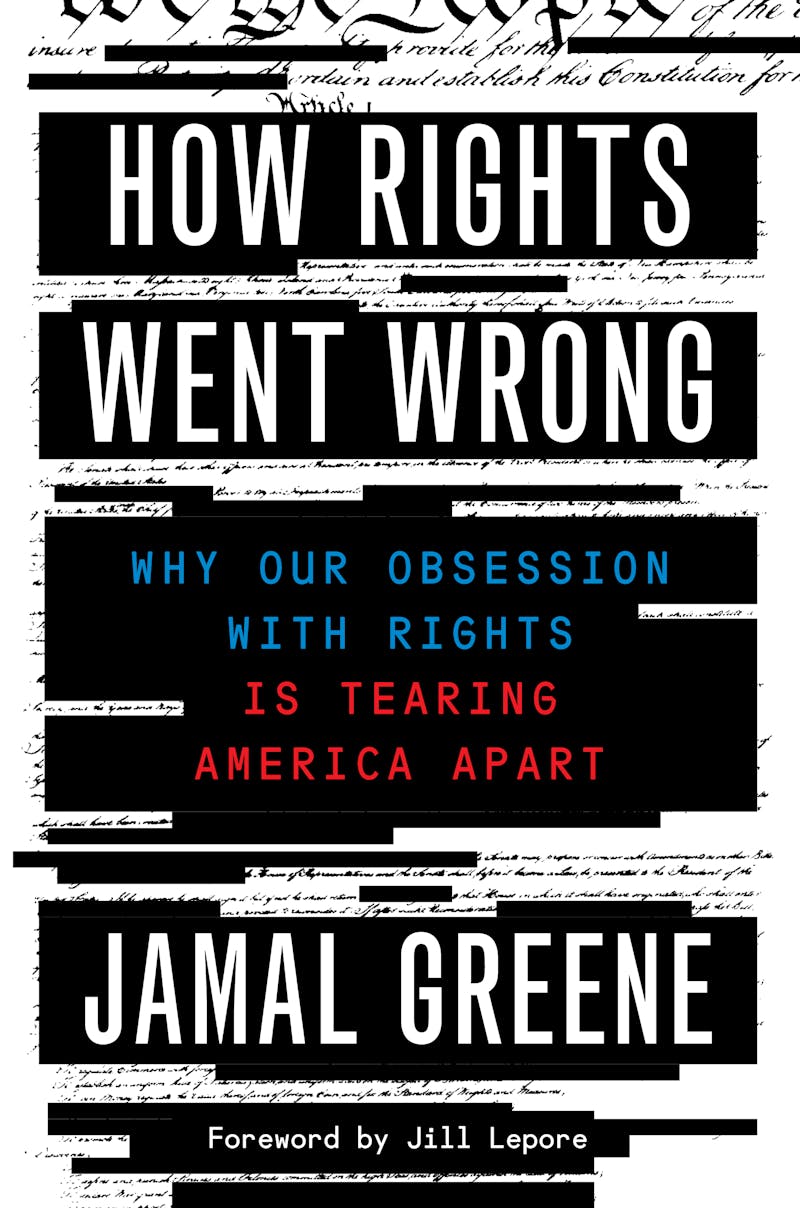In 1991, Harvard Law professor Mary Ann Glendon came out with Rights Talk, a warning that Americans had embraced a divisive understanding of rights that would lead the country into greater and greater strife. Americans, she argued, tended to regard declaring a right as the solution to any problem—and the more absolute the right, the better. Getting your right honored allowed quick victory, often in court rather than politics; but the wrong people usually won, and even when the right ones did, it left polarization in its wake. America’s most renowned theoretician of rights, the late Ronald Dworkin, had argued that rights are like “trumps” in a card game that make majorities irrelevant, and oblige judges to ignore them. For Glendon, such a political culture distracted from communal life and hard questions, and it was not making things better, but worse.

Her point was not to take rights less seriously—she celebrated how the civil rights movement had helped end American apartheid. Born in western Massachusetts, she had participated in the civil rights movement herself and married an African American man several years before the Supreme Court, in Loving v. Virginia (1967), decreed that the right to marry meant anti-miscegenation laws that remained in the states were unconstitutional. But she worried that the invocation of rights was now serving only “to heighten our awareness of how deep, stubborn, and complex are the nation’s problems of social justice.” Judges were saddled with the task of solving them, which they failed to do; the Supreme Court could, for instance, order schools to integrate, as it did in Brown v. Board of Education, but it could not prevent the intractable disputes that followed over busing. The rights that judges enforced in absolutist terms remained a short list, with speech and property at the top of the list. And for Glendon, a Roman Catholic, the addition of abortion rights in Roe v. Wade had inflamed the country rather than unifying it.
She proposed that rights didn’t have to be polarizing. Renowned as a comparative lawyer, Glendon wrote glowingly of how Europeans accepted entitlements favoring laborers and poor people. They could do so because they treated rights with less absolutism than Americans do. Europeans had more rights, but adopted them in a more communitarian spirit, reconciling them with other commitments. To establish a right to abortion, American progressives relied on the absolute right to “privacy”; by contrast, German judges hewed out an entitlement to abortion by acknowledging competing claims and interests, including that of unborn life. Poor German women, as a result, had a less fortified abortion right on paper but easier access to abortion in a generous health system, while American constitutional law gave “poor, pregnant women” a “constitutional right to privacy and little else.” No fanatical Reaganite, Glendon was looking for a political alternative back then; America’s rights culture was not helping bring it about.
Glendon, who retired last summer, has had a troubling trajectory since. Drifting right from the moderation of Rights Talk, she became increasingly close to Christian reactionaries. She has served as United States ambassador to the Holy See, and in several Vatican posts, hardening her opposition to abortion rights (including when she boycotted Notre Dame University rather than share the stage with pro-choice President Barack Obama). On meeting her former research assistant Mike Pompeo as a Harvard Law student, she recalled thinking: “Boy, this is just the kind of person we need in politics!” When Pompeo became a catastrophic secretary of state under Donald Trump, Glendon—since best-known as a scholar for attempting to reclaim international human rights from what she takes to be their left-wing abuse—headed Pompeo’s much-reviled Commission on Unalienable Rights.
American history works in mysterious ways. Glendon’s subsequent evolution should not distract from the fact that many of her original arguments were convincing and deep. And now they have been rescued by a brilliant liberal scholar, who has taken them to a new level by transforming them, at a moment when America is more divided than ever, and rights remain as much the problem as the solution.
Jamal Greene’s new book, How Rights Went Wrong, renovates and updates Glendon’s indictment of American “rightsism” since the 1960s, with its own glances abroad for a better way. Now a highly regarded professor at Columbia Law School, Greene worked for Sports Illustrated before going to law school, and his writing makes the human stakes of otherwise abstract legal choices clear and dramatic (and with lots of good snark to lighten the mood).
Whereas Glendon ranged across many areas of law, Greene focuses on America’s constitutional law. In his version, the Supreme Court needed to affirm strong rights to end Jim Crow, but sharpened this need into a universal model that made some rights sacrosanct while putting others in the shade. The highest court played an indispensable role in ending some forms of vicious white supremacy in Brown and criminal justice cases, by destroying “separate but equal” institutions and affording defendants rights against overzealous policing and prosecution. But by the same token, a range of other desirable values, notably welfare entitlements, was given no judicial protection.
The main reason, Greene explains, was overreaction to the Supreme Court’s “defining mistake” in the period between America’s founding and the civil rights era. The Constitution got captured by ideologies of economic freedom in the late nineteenth and early twentieth centuries. Lochner v. New York (1905), most notably, read a right to freedom of contract unmolested by the state into America’s fundamental law, in order to invalidate government regulation of working hours and workplace safety. In response, Greene shows, jurists like Supreme Court Justice Oliver Wendell Holmes and especially his self-appointed progressive heir and later Justice Felix Frankfurter tried to restrict constitutional protection to a few nonnegotiable rights, and get the Constitution out of the way otherwise. The results were to allow African Americans in the civil rights era and other minorities later to use the Constitution as a sword against majorities oppressing them, while keeping business interests from adopting it as a shield against majority rule.
In Greene’s telling, this “discriminating” approach to rights, magnifying a few and negating most, was a calamity. It made sense to fortify rights as a battering ram to breach the walls of Jim Crow, while making sure that economically progressive legislation survived the assertion of rights of business interests. But in the long run, he argues, this “two-track” approach has been “completely inadequate, even dangerous.” Judges picked some winners of the sweepstakes in free speech, personal autonomy, and private property cases, and awarded them strong rights; but most people lost.
All along there was another model, which Greene labels “reconciling” rights. In the United States, two Supreme Court justices named John Marshall Harlan championed it, one serving after the Civil War and the other, his grandson, a century later. Though it never took hold here, it would eventually conquer European and global law under the label “proportionality.” On this model, the judge faced with a rights claim must assess how important it is, relative to the state interest that allegedly threatens it. No or almost no rights ought to be absolute, as Glendon already ventured. But whereas Glendon mused vaguely of the need to restore the missing dimensions of community and responsibility, Greene points to the need for decision-makers to have a fact-based method for squaring the individual or minority right claimed with the government or majority interest. Sometimes the first must overcome the second, but not necessarily, and only after being defined carefully. Indeed, even with rights many Americans think about as absolute—like the rights to property and speech—judges already engage in such “mediation,” weighing interests of individuals and minorities against the collective and the majority.
This approach would offer a way through some of the more divisive cases the Supreme Court has seen in recent years. Greene cites as an example Masterpiece Cakeshop v. Colorado Civil Rights Commission (2017), in which a baker invoked the Constitution’s First Amendment protection of religious freedom to get out of baking a wedding cake for a same-sex couple. In this situation, his religious freedom ran up against his state’s prohibition on discrimination against gay people. For Greene, the beginning of wisdom is recognizing that it is a case of colliding rights, not locating which is the real one. And it is crucial to see how narrow an exemption Jack Phillips, the baker, wanted: not to discriminate against gay customers, but to opt out of baking for same-sex ceremonies for any customer, even if the couple’s straight friends or relatives wanted to buy from him. It was not “existential,” but the courts exacerbated a culture war, when they could have taken sides after giving each side more consideration.
For Greene, as for Glendon before him, the true paradise of rights thinking is Europe. There the dominant approach is reconciling rights, or “proportionality.” Like Glendon, Greene compares the divisive Roe v. Wade decision granting women the absolute right to first-trimester abortion (and no rights to fetuses) to German jurisprudence, which led to less backlash and discord. For good measure, Greene throws in a comparison of Masterpiece Cakeshop with Lee v. Ashers Baking, a very similar British case in which anti-discrimination law collided with religious conscience, but with less angst and outrage as a result. In the dispute in Northern Ireland, the British Supreme Court found that this baker wasn’t necessarily discriminating against gay people if he didn’t want to write messages on his cakes supporting the institution of gay marriage.
In both abortion and gay rights, Greene contends that Americans have been led into near civil war by the belief that they can have only a supercharged but small set of rights. It could have been otherwise, he says, and if judges could move from picking winners (and enraging losers) to reconciling parties, Americans could embrace more rights for more people. It is here that Greene goes beyond Glendon, who called for fewer rights and less rights thinking. Greene’s prescription is in effect for more numerous but sometimes weaker rights, with strong courts that can give a greater suite of entitlements all their due—he cites the example of affirmative action (which the Supreme Court is likely on the verge of holding unconstitutional) and disability rights. Citizenship would become more meaningful, even as interpreting rights proportionally to their importance (and to contending interests) would make sure they do not alienate and polarize majorities, but instead modestly and properly check them.
But if rights divide Americans, would better constitutional judging really achieve both more just outcomes and more unifying ones?
Greene recognizes that the more rights we believe we have, the more give-and-take there will have to be around their vindication. “Fights about rights,” he wisely remarks, “are a byproduct of human pluralism, an inescapable symptom of the human condition.” As he negotiates fairly the alternative interests at stake across a series of case studies, he demonstrates an extraordinary level of empathy toward those whom most liberals would treat as despicable political enemies. Greene—currently co-chair of the Facebook oversight board that adjudicates the company’s censorship decisions (including the suspension of Donald Trump)—shows how great a judge he himself would make, if Joe Biden is smart enough to appoint him.
But Greene’s focus on how judges should decide rights cases raises the question of how great a role judges ought to play in rights politics in the first place. “A constitution for the modern world,” Greene asserts, “asks judges neither to ignore nor to supplant politics, but rather to structure it, to push it, and to police it.” No doubt there is a place for judicial authority when democracy goes badly awry. But the more rights we claim, and the more they can conflict with other people’s rights or be overridden by other interests, the less credibly judges can make a call about where entitlements begin and end. Greene acknowledges how terrible it is that Americans “see deciding what rights we have and what rights we don’t have as simply the thing that courts do.” But within a few pages he himself writes with strange regret that sometimes “courts necessarily must cede some power to recognize and enforce rights to political actors”—as if this were a bad thing.
Proportionality, which Greene invokes, tends to be a smoke screen for transferring lots of policy choice to unelected judges, who are less accountable than legislators. Greene forthrightly insists that rights questions are generally not titanic contests of good and evil but rather questions of judgment, “not the glass we break in the emergency of a government captured by bigots or morons,” but “predictable byproducts of ordinary governance in a pluralistic society.” This very fact suggests that we need to know why judges ought to be allowed to reach a different conclusion than politicians, except when the latter become truly bigoted or moronic. Greene convincingly suggests that if judges were less absolutist about rights, they would “channel conflicts away from courts, which are ill-suited to open balancing, and into politics.” But then why not make the project of reconciling our rights an invitation, not so much to proportionality balancing in courts as to transfer of power away from the judiciary and toward political branches of government?
For Greene to respond, a lot depends on whether European or global courts really do a better job. This is open to question. Parallel British debates around rights, which increasingly resemble American ones (in spite of the difference that British courts answer to Europe’s human rights law and its human rights court), suggest not. Rather, if courts elsewhere have sometimes gotten away with less scrutiny than in America’s decades of “notorious” Supreme Court justices, it is probably because for a while their societies were less divided, not because courts there actually avoid contestable policy choices. Greene’s comments on the abortion and gay rights areas sometimes read like invitations to cede even more ground to American conservatives on cultural issues, in an era when the Supreme Court has let them win on so many other fronts. It is hard to believe less social conflict would result, if only conservatives would get their way even more often.
At the same time, Americans are more and more recognizing that the role courts play in our society is less a polarizing than a partisan one, captured by right-wing ideology, even before Amy Coney Barrett’s replacement of Ruth Bader Ginsburg. For several decades now, our judges have been failing to enforce relatively uncontroversial rights for the vulnerable and weak, while falling back into the habit of taking the rights of the powerful and rich seriously. Greene complains that our Constitution (unlike most around the world) lacks socioeconomic guarantees, and our Supreme Court has destroyed hopes of seeing educational and welfare rights interpreted into it. Writing at the dawn of the neoliberal age, Glendon did much better in noting how systematically the law has been moving to favor corporate interests over the working class. This has been anything but an accident, and not just because Republican judges have been groomed to do so; justices appointed by Democrats are today more business-friendly than in a century.
Meanwhile, American history shows that citizens owe many rights they enjoy less to courts interpreting the Constitution (unless you are rich) than to legislatures providing them in response to social movements. Congressional statutes like civil rights laws and the Voting Rights Act of 1965—protections that the Supreme Court has treated very badly—are good examples, often correcting earlier judicial malfeasance. Disability rights are a just cause, but faulting the Supreme Court for failing to read them into the Constitution seems less pressing than pondering the fact that it was the legislature that acted to declare new entitlements. The lesson of American history is that the politics of rights needs democracy more than it needs proportionality. Democratic action for renovating citizenship could even include more amendments (which originate in the legislature) for better versions of old rights and altogether new ones, like socioeconomic protections.
In a provocative part of his book, Greene treats Frankfurter as a cagey opportunist who wanted to liquidate most rights out of concern with how far courts served big business, leaving judges to defend only a few sacred freedoms. “American courts continue to frame rights as all or nothing,” Greene writes. Yet, unlike Holmes, Frankfurter was not a cynic about rights; he was a progenitor of democratic ones. “Reliance for the most precious interests of civilization,” Frankfurter put it in the most moving passage in constitutional law I know, in a dissent in the case of West Virginia Board of Education v. Barnette (1943), “must be found outside of their vindication in courts of law.” For Frankfurter, once we realize that there is a politics of rights, it is our task as democratic citizens to define and defend what we care about.
This does not mean there are guarantees that our side wins every time. But rather than pining for some era of lost American unity before rights talk came, as Glendon did, or calling for better judicial procedures, as Greene now does, we have to recognize that the only way to make the citizenship everyone deserves is through democratic contest and engagement. Greene’s warning about the absolutism of rights in the hands of judges shows why political decision-making needs to be wrested from them in the coming years. What Frankfurter said of liberty is true of equality and solidarity: Our entitlements are those we must provide one another in clashes of vision, and successes in winning enough backing for our side. This is not nihilism. It is the recognition that, while democracy is nowhere close to affirming and defining all the rights we need, there is no one else to do it but us.








